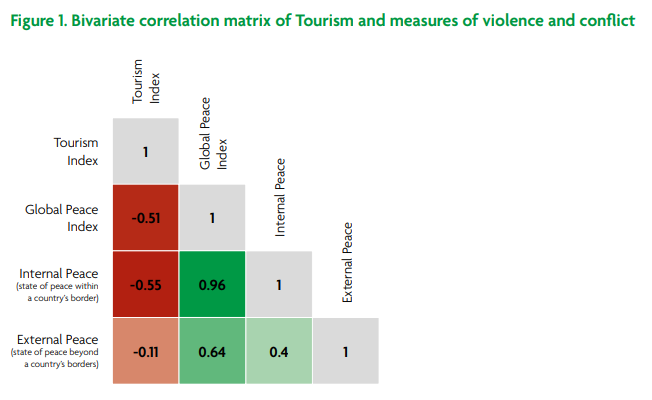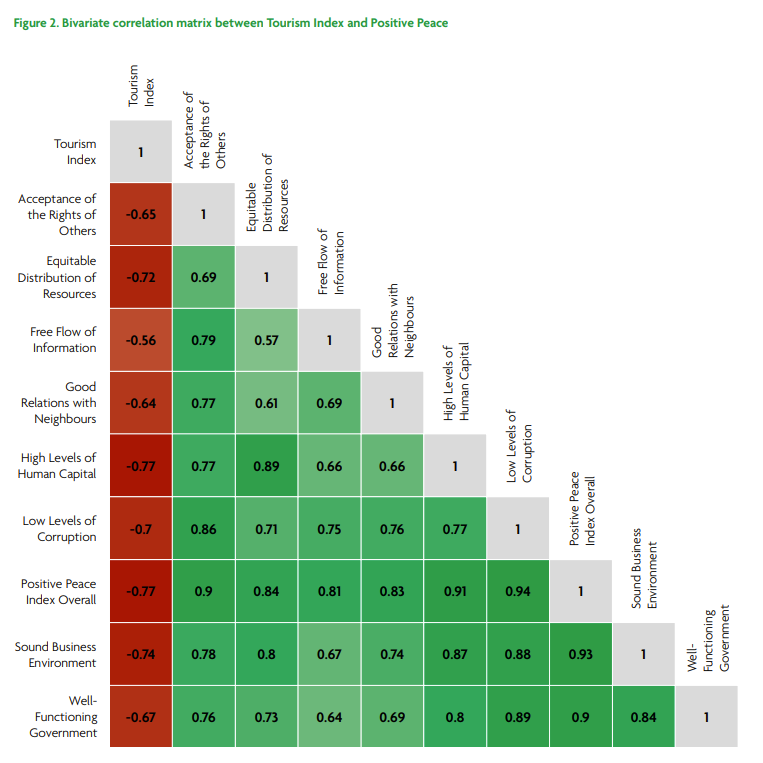The movement of people all around the world is much more than a leisurely escape from the rigours of daily life. IEP’s research finds that the strongest link between tourism and peace can be found when analysing Positive Peace. IEP defines Positive Peace as the attitudes, institutions and structures that create and sustain peaceful societies.
Positive Peace is measured by the Positive Peace Index which is calculated upon eight distinct pillars, which IEP have deemed as the essential requirements for a peaceful society: sound business environment; good relations with neighbours; high levels of human capital; acceptance of the rights of others; low levels of corruption; a well-functioning government; free flow of information; and the equitable distribution of resources. The maintenance of an open and sustainable tourism sector will equate to high peace levels, particularly about the attitudes, institutions and structures that define peaceful societies.
In an attempt to directly examine the relationship between tourism and peace, the World Travel & Tourism Council (WTTC) previously partnered with the IEP to develop a Tourism Index that can measure the prosperity of a country’s tourism sector, in relation to factors of sustainability and openness. Consensus found that there are four vital domains that must be accounted for: socio-cultural, economic, political and environmental.
In order for tourism to flourish, it must first be desirable. Tourism therefore has the ability to support peace regulation as pressure is put on governments to cease conflicts and establish trustworthy and harmonious relationships with citizens, to attract tourists and reap the economic benefits of tourism. A key example of this relationship in action is in Rwanda, where government-imposed efforts to clear landmines, invest in wildlife and rebuild the country’s image actively promoted gorilla trekking, making the country a sought-after destination for ecotourism.
Figure 1 reveals the relationship between tourism openness and sustainability, and violence and conflict as measured by the Global Peace Index (GPI).

Figure 2 shows the relationship between the Tourism Index and measures of Positive Peace, revealing a strong correlation that reflects the positive relationship between levels of positive peace and tourism sustainability.

The truth of the modern world is that Earth is becoming an increasingly violent place, and IEP has been tracking this trend for some time. The 2023 GPI recorded the thirteenth deterioration in the peacefulness of the last fifteen years, year-on-year the greatest deteriorations stem from the indicators of external conflicts fought, deaths from internal conflict and political instability.
Increases in violent conflict in countries such as Ukraine, Russia, Haiti, Mali and Israel actively increase the number of displaced persons. Despite this, IEP’s previous research has found that there is a weak negative correlation, at a global level, between changes in the Tourism Index and changes in the Global Peace Index, indicating that even in non-conflict-affected countries, when the security situation deteriorates, tourism does not necessarily suffer. An exemption of course is the most recent example of the COVID-19 pandemic, which actively deteriorated tourism on a global scale in attempt to stop the spread of COVID-19.
Terrorism will have impacts on tourism, particularly when tourists become the deliberate target, as was the case in Egypt when a tourist bus was bombed in 2018, or the Tunisia beach shootings in 2015. However, IEP’s research finds that the impacts terrorist activity has on the tourism sector are short-lived. Often brought about by travel advisory warnings which cause short term decreases in tourist activity, after the situation cools down, tourism will often return to a healthy level if the threat of terrorist activity has declined. It is expected that repeated acts of terrorism in an area will have long-term effects on an area’s tourism levels.
If there is one thing we should reflect on this coming World Tourism Day, it is the world we lived in when tourism and travel were not options. The COVID-19 pandemic’s halt on tourism was unprecedented and saw a range of negative outcomes such as civil struggle, job losses, declines in information spread and distrust among neighbouring states.
Whilst it was a source of deterioration for many during the pandemic, the path the world took out of the COVID-19 disaster was boosted by tourism and its ability to influence the building of Positive Peace. This article briefly summarises a body of research that has investigated global patterns and trends in peace and its relationship with tourism. Without delving into the complex discussions of causality or determinants, the proposition of tourism directly impacting peace invites many more avenues for research, discussion and data collection.